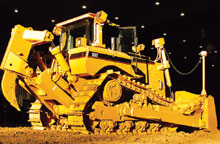Caterpillar Chalks Up 100 Years of Tracks By Introducing Three New Crawler Dozers
 |  |
| Evolution. Benjamin Holt (left) laid trackwork for Cat and great-grandson Peter. | |
Judging by the heavy technological changes in Caterpillars new T-Series tractors, the next century of tracks is shifting from a slow crawl into high gear.
Caterpillars newest earthmoving machines, unveiled late last month and scheduled to arrive next spring, are designed to be more efficient, productive and serviceable than before.
Various updated features include cleaner-burning engines, onboard diagnostic tools, electrohydraulic controls, GPS earthmoving technology and longer oil-change intervals that keep machines working hard in the field rather than waiting for service.
The new dozers bear little resemblance to their 20th century ancestors except for the way they "walk." On Nov. 24, the Peoria, Ill.-based manufacturer celebrated the centennial of the construction industrys first crawler tractor. Benjamin Holt mounted wooden tracks on his companys steam-powered engine No. 77 and tested it in 1904 in Stockton, Calif. He sold his first "Caterpillar" tractors in 1906 for $5,500.
Holts design, tried unsuccessfully by his peers, was a significant breakthrough that "started an industry," says Keith Haddock, author of The Earthmover Encyclopedia. The ability to distribute weight over more ground has made tracks a common mode of travel for countless other construction machines.
 |
 |
| (Photo top courtesy of Caterpillar Inc. Corporate Archives; bottom by Tudor Hampton for ENR) |
One week before the centennial, Cat showed ENR its latest crawler tractors, the D8T, D9T and D10T. The 310-to-580-hp machines replace R-Series models designed in the 1990s. With a typical price tag of $524,000, the new D8 is the first T-Series tractor in production and continues a long line of D8s that first hit the dirt in 1935.
Site Concrete Inc., Grand Prairie, Texas, bought the first D8T from Holt Cat, San Antonio, the largest Cat dealer in the U.S. At the dealers helm is CEO Peter M. Holt, great-grandson of track pioneer Benjamin Holt.
Midwest Cat dealer Patten Industries Inc., Elmhurst, Ill., has two D8Ts on order, with delivery scheduled in late spring. According to Matt Lamacki, sales manager, the D9T and D10T will be available later in about 39 weeks. "Cat has more orders than it knows what to do with," he says.
The T-Series comes with clean diesel technology, drive-by-wire control, in-cab diagnostics and a new "Accugrade" option for GPS earthwork. Retooled engines comply with federal emission rules coming in January for large, off-road diesels rated 300-750 hp. The D8T is Cats first machine to feature its "ACERT" off-road engine, designed to meet U.S. and European air-quality regulations into the next decade. Cat now has 120,000 on-highway versions running in the field, according to Jim Owens, chairman and CEO.
Company officials claim that electronic programming helps the engines comply with global emission standards and makes them a flexible power source for contractors working overseas. Also, onboard computers double as diagnostic tools and operator aids. Plugged into optional GPS controllers, they can digest 3-D site plans and help operators grade within one-tenth of a foot.
On smaller crawlers, a new undercarriage option called "SystemOne" is Cats latest track innovation. Gwenne Henricks, product manager, says it reduces operating costs by 30 to 50%.
Henricks calls new idlers, cartridge-style joints and other wear-resistant components the "biggest thing to hit undercarriages since we elevated the sprocket." First introduced on the D10 in 1977, Cats triangular "high drive" undercarriage also helped contractors get more life out of their tracks.
Cats elevated sprocket stems from early 1914 prototypes, but the firms legacy wasnt sealed until 1925, when Holt Manufacturing and competitor C.L. Best merged. Caterpillar Inc. now is a $22.8-billion-a-year firm, having shipped millions of machines worldwide and holding the bittersweet title of largest equipment maker on Earth.
